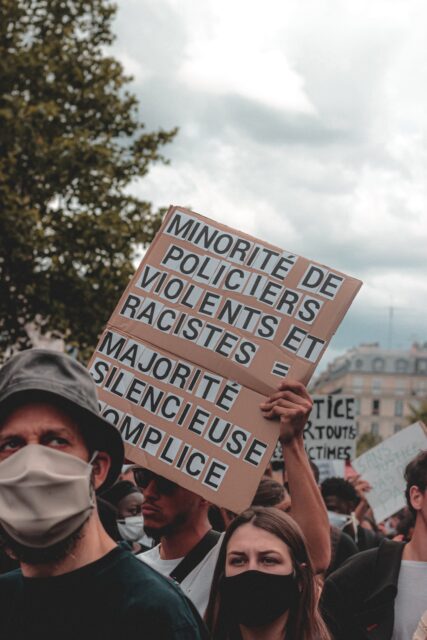Why all this effort? A look at activism and the Corona crisis
Year of production: 2020
Photo by Sergey Zolkin on Unsplash
The best of times, the worst of times
It was a cloudy mid-March afternoon when, without wanting to, I caught myself thinking: This is the end. For activism, at least. After all, how can one participate in a protest, campaign for an issue or volunteer at an NGO when social distancing and quarantine are imposed? Isn’t activism by definition meant to be active, to have you stepping outside, bravely showing the world your message? Braced with such a dire prognosis, it is needless to say that what happened next took me by surprise: despite the outbreak, there appears to have been an increase in the level of interest for activism among young people. One only needs to take a look at the news cycle to see this surge. Protests erupted across Europe in solidarity with the Black Lives Matter movement, with people signaling racism in their own countries. Polish women’s rights activists protested the need for sex education and safe abortions against regressive bills previously proposed in parliament. Once more, activists supported them with the hashtag #protestathome in solidarity. The youth-led movement against climate change has also found an audience online. Every Friday, people on #DigitalStrike united to urge people to understand the dangers of climate change. Earth Day was marked with a live-streamed “digital march” with speeches, music, and protests. The international youth movement for climate change Fridays For Future organized a live-streamed digital strike attended by over 230,000 viewers. Activists, organizations, and movements have all united their forces in pushing for change in new and creative ways, such as practicing self-care and community care or creating fanzines. There was an increase in collaborations and sharing initiatives, support, and resources to respond to the Corona-generated crisis within the activism community at large through webinars, conferences, training tools, and crowdsourced online documents. Activism is currently undergoing an interesting evolution, as movements and organizations are learning to adapt their tools and systems to mobilize people while overcoming physical distancing limitations. But a question remains: why?
The activist brain
While there is no clear-cut answer as to why people engage in activism, and even less so as to why people choose to disregard personal safety and engage in activism during a potentially deadly pandemic, there might be a common psychological foundation behind the “activism mentality”. Social psychologists Jacquelien van Stekelenburg and Bert Klandermans (2013) from VU Amsterdam have scoured much of the literature concerning activism, particularly the act of protest, and came up with five main motivations:
Grievances
Feelings of injustice, inequality and moral indignation at the current state of affairs in society creates a demand for change. If people see that nothing is happening, they might feel that they have to take the situation into their own hands.
Efficacy
Efficacy is the belief that a person can change their conditions through activism. The authors found that those who believe in the power of efficacy were likely to engage in actions such as protests.
Identity
The more one identifies with a group, the more likely he or she is to participate in protests benefiting that identity. Even if not a part of an oppressed group, empathizing and working together with others who are can build awareness of your shared conditions under the same political system, a fact which in turn can lead to engagement in activism.
Emotions
Described by the authors as a central protest emotion, anger can act as a motivator for activism, as it creates a “more challenging relationship with authorities than subordinate emotions such as shame and despair”.
Social Embeddedness
Activism relies on people coming together to create change. Talking to others about what’s wrong at a societal level is important as it creates group grievances and emotions rather than personal ones, hence bringing individuals together under a common goal.
Crises as a motivation
These five factors can offer an understanding as to why activism happens in general. Still, there is the question as to why this pandemic has been such a strong catalyst for action. The reason might lie in one simple word: crisis. As it has been noted, crisis situations, whether in the shape of a natural disaster, a financial collapse or, as in this case, a pandemic, almost always generate strong emotional responses in those affected. While many of these feelings are on the negative spectrum (hopelessness, anxiety, denial, outrage), there are also positive emotions that can be enhanced by a crisis, such as responsibility, self-sacrifice and empathy. While difficult to quantify, a growth in these abilities could lead to a better ability to relate to the struggles of others. This emotional change has taken a different form in both online and in-person activism. In the case of online activism, research (Aiello L.M., Quercia D., Zhou K., Constantinides M., Sc ́epanovic S. ́, and Joglekar S., 2020) has shown that people have become more likely to share personal information regarding themselves and their stances on certain issues during the pandemic. In part this could be due to the desire to still feel connected and identify with others through an online medium in the absence of physical interaction. Various publications have highlighted the fact that the pandemic can serve as a moment of self-reflection and change: people get to spend more time alone, thus becoming more in touch with their emotions, beliefs and perhaps more understanding of social injustices taking place. Interestingly, it appears that crisis events don’t actually cause people to fundamentally change their opinions, therefore it is likely that these individuals held such beliefs before the onset of COVID-19 but have now become more open and more educated about them.

A constant calculation
In-person activism is slightly different, as people are taking on the additional risk of endangering their lives by being in close proximity to large groups of people, oftentimes without masks. Yet such apparent disregard for one’s health still carries behind it a degree of calculation. According to the appraisal theory of emotions, people are always evaluating the relationship between their environment and their well-being (Scherer, Schorr and Johnstone 2001). After looking at an event’s implications in terms of their own well-being and their ability to cope with the ongoing issues, an individual could decide that it is worth becoming involved. This might be a reason for why crises cause many to step up, as they perceive an urgent threat to their existence which outweighs potential health-risks. For example, in the past one finds the Suffragettes continuing the fight for Women’s Emancipation despite the ongoing influenza or, more recently, people in Hong Kong protesting the postponed local elections although risking imprisonment as a consequence. Across Europe, we have seen thousands protesting for their cause. In France, despite the rapid spread of the virus, the Yellow vests have continued their manifestations for economic justice. This summer we saw record numbers of people protesting in solidarity with George Floyd’s murder, a fact which is both heartwarming and intriguing, especially when compared to the reaction to the killing of Michael Brown in 2014. While causing condemnation from EU politicians and activists alike, this similarly cruel act of police brutality did not cause such an intense response worldwide. It is perhaps the imposed social isolation coupled with a mixture of various unfortunate events throughout the year (threats of a Third World War, Australian fires, the failed impeachment of president Trump and the Beirut explosion, just to name a few) that exacerbated the anger of people at societal injustices compared to previous times. While the risk of catching and spreading the virus still looms, people seem to be increasingly concerned with inequality and the desire to see effective change taking place now. The protests concerning the result of the recent elections in Belarus are an even more extreme example of how fighting for democracy (the absence of which is a direct threat to one’s existence) can overcome the fear of illness or abuse (also direct threats to one’s well-being).
Next steps
What the Coronavirus crisis has shown is that activism does not have an expiry date. It might change in form (from in-person to online) or be amplified, but it is unlikely that it will disappear, even in situations of crisis. On the contrary, a crisis is more likely to stimulate the desire to fight for change, which might be exactly what society needs right now. As the future shapes up to be challenging, from issues of global warming to illiberalism, it is vital that activism persists and adapts to the times.





